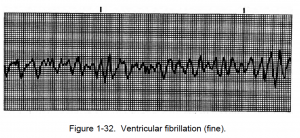d. Ventricular Fibrillation. Analysis of ventricular fibrillation is given below and examples are shown in figures 1-32 and 1-33.
(1) The rhythm, rate, P waves, P-R interval, and QRS complex are totally chaotic with no discernible waves or complete complexes in this abnormality.
De-Rhythm ventricular fibrillation (CardioNetworks_ECGpedia). By CardioNetworks: Googletrans [CC BY-SA 3.0 (http://creativecommons.org/licenses/by-sa/3.0)], via Wikimedia Commons
(2) The ventricles fire in a totally disorganized fashion and, instead of beating, the ventricular muscle quivers. Consequently, there is no cardiac output and the ventricular fibrillation is the same as death. The casualty is clinically dead. Normal heart rhythm must be restored within a few minutes or biologic death follows.
(3) When you see a rhythm on the monitor that resembles ventricular fibrillation, check quickly to be sure this pattern is not caused by muscle tremor, loose leads, or patient movement artifact.


Figure 1-33. Ventricular fibrillation (coarse).

![1-11. VENTRICULAR ARRHYTHMIAS: D. Ventricular Fibrillation 1 De-Rhythm_ventricular_fibrillation_(CardioNetworks_ECGpedia). By CardioNetworks: Googletrans [CC BY-SA 3.0 (http://creativecommons.org/licenses/by-sa/3.0)], via Wikimedia Commons](https://brooksidepress.org/ecg/wp-content/uploads/2015/11/De-Rhythm_ventricular_fibrillation_CardioNetworks_ECGpedia-300x67.png)